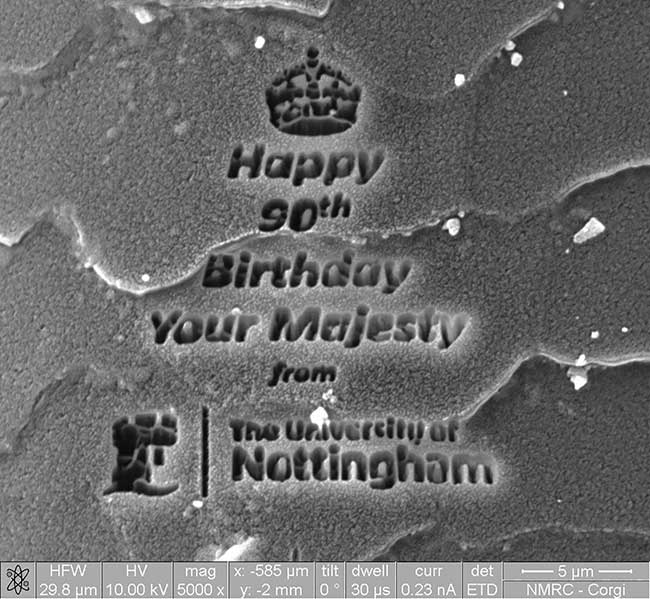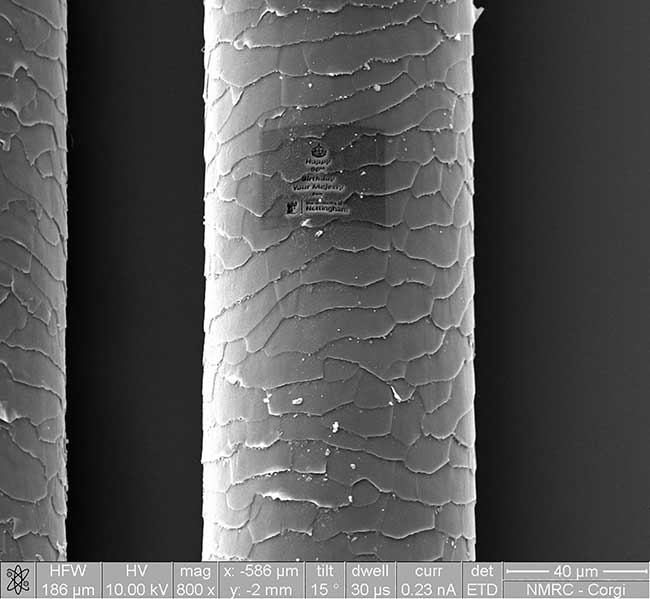Queen Elizabeth II has owned at least 30 Pembroke Welsh corgi dogs in her lifetime, ever since her father, King George VI, brought home Dookie when she was a child. So when scientists at the University of Nottingham — who hold the world record for writing the smallest version of the periodic table on a human hair — wanted to demonstrate technology at the new Nanoscale and
Microscale Research Centre (NMRC) earlier this year, they didn’t use just any hair … they chose a corgi hair.

Courtesy of the University of Nottingham.
NMRC, in Nottingham’s School of Chemistry, opened in April, during the same week as the Queen’s 90th birthday. Michael Fay, senior research fellow in engineering, and Christopher Parmenter, research officer in the university’s School of Pharmacy, saw this as an ideal way to not only test the new facility’s technology, but also pay tribute to Queen Elizabeth. The microscopic message — “Happy 90th Birthday Your Majesty, from The University of Nottingham” — was etched onto hair that was about one-tenth of a millimeter wide; the hair came from dogs that are related to the royal pets.
To do this work, the researchers used a focused ion beam scanning electron microscope, which is used to etch and precisely manipulate materials. The microscope projected a beam of gallium ions onto the hair’s surface, and removed its top layer to allow the message to be imprinted.
“It’s a truly magical process to observe that message just all of a sudden pop out,” Parmenter said in a talk with the BBC. He added that his team was hoping to get the message to the Queen herself.
There has been no word yet from Buckingham Palace on whether this tiny tribute was received.
“I think the significance of doing this sort of thing is really to get
the public outreach beyond the ‘easy targets,’” Fay said. “It might be
all too easy to spend our time talking to people who go to science
festivals and pub lectures. … The more ‘for fun’ things such as this can
have a wider reach.”

A corgi dog hair as imaged with microscopy technology at the
University of Nottingham’s new Nanoscale and Microscale Research Centre.
At the center of the hair, the etched message can be seen. Courtesy of
the University of Nottingham.
This is the second time that the Queen has become part of the University of Nottingham scientists’ research.
In 2012, Parmenter, Fay and Martyn Poliakoff, a research professor of chemistry, engraved a microscopic portrait of her on a “second-hand diamond” using similar microscopy techniques as the more recent corgi hair feat — a beam of charged gallium ions enabled the engraving, which measured 46 by 32 µm, according to the scientists.
The new NMRC, a £12 million facility, touts the latest in microscopy technology, and offers expertise in nanoscale characterization, specialized sample preparation, and micro- and nanostructure fabrication. It features a comprehensive sample preparation laboratory, and a suite of 20 major instruments including surface characterization equipment (among them, spectrometers and Raman microscopy tools).